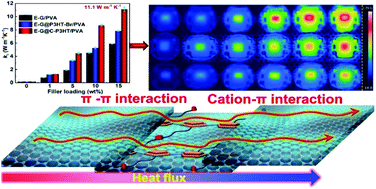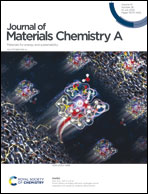A dual non-covalent bonding constructed continuous interfacial structure for reducing interfacial thermal resistance†
Abstract
Polymer-based thermal conductive composites are essential to alleviating heat accumulation in electronic equipment. However, non-neglectable interface thermal resistance between fillers is unfavorable to their thermal conductivity, thus invalidating their applicability to electronic components. In this work, a low thermal resistance interface structure in adjacent graphene was constructed by functionalization of cationic poly(3-hexylthiophene) (C-P3HT) on an exfoliated graphene (E-G) surface. A “dual channel” for heat transfer between graphene layers was created through cation–π and π–π interactions between quaternary ammonium and the thiophene ring in both C-P3HT and E-G. The “dual channel” structures are assisted by C-P3HT with intrinsic thermal conductivity to form a continuous in-plane heat transfer pathway in composites. The advantage of E-G@C-P3HT/PVA results in a very high in-plane thermal conductivity up to 11.1 W m−1 K−1 along with good mechanical properties. The enhanced heat transfer effect of “dual channel” structures was further verified by molecular dynamics simulation analysis of phonon transport behavior at the interface of C-P3HT modified E-G. This study provides a new way to improve the thermal conductivity of composites by effectively reducing the interface thermal resistance.



 Please wait while we load your content...
Please wait while we load your content...